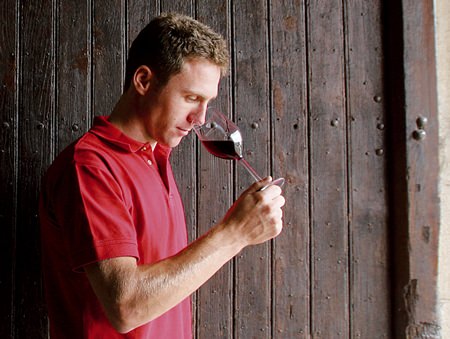If you’re over a certain age, you may recall the satirical novel Clochemerle which was set in a small village in Beaujolais. In 1972, BBC television produced a series based on the novel, filmed on location in France. Many viewers must have thought that they were seeing the real Beaujolais, but the programmes were actually filmed in a village called Colombier-le-Vieux in the Ardèche, over ninety miles to the south. The “real” Clochemerle is a village called Vaux-en-Beaujolais, a picturesque little place sitting among acres of vineyards.
The area known as Beaujolais (boh-zjuh-LAY) begins just north of the huge city of Lyon and extends about thirty-five miles north to the bustling country town of Mâcon. The region was first cultivated by the Romans, who very sensibly planted vines along their trading route up the Saône River valley. Unlike the red wines of Burgundy which rely totally on the Pinot Noir grape, Beaujolais is made from Gamay, a purple thin-skinned grape which is low in tannins. Almost all the wines made there are red, full of fruit, easy to drink and food friendly. Beaujolais is made to be enjoyed young when it’s full of youthful exuberance and on home ground it’s usually served slightly chilled. In his splendid book Adventures on the Wine Route, Kermit Lynch writes, “What a concept, downing a newborn wine that has barely left the grape, a wine that retains the cornucopian spirit of the harvest past.” But Beaujolais has changed, much to the chagrin of the Old Guard. Fifty years ago it was a simpler wine, sometimes a bit rough even, but rarely exceeded 10-11% alcohol content. Today it is more likely to be 12.5% and crafted for more sophisticated customers who demand more flavour, smoothness and a bit more class.
 François Jaubert, viticultural adviser and winemaker for Mommessin.
François Jaubert, viticultural adviser and winemaker for Mommessin.
The quality levels of Beaujolais are easy to understand because there are only three of them. The lowest is labelled simply Beaujolais and it’s a basic blend using cheap grapes from anywhere in the region. A wine labelled Beaujolais Villages is at the middle level and covers blends from any of thirty-nine small villages in the northern part of the region. Wines from these villages are considered superior to ordinary Beaujolais in that they have more complex aromas and a better concentration of flavours. The top-level and best wines are known as Cru Beaujolais and come from just ten villages in the foothills of the Beaujolais Mountains. The name of the individual village is usually printed in bold type on the label and sometimes the name Beaujolais is omitted altogether. These are the best Beaujolais wines you can buy. The wines of each village have their own special characteristics and the wines you are likely to find around here are from Brouilly, Chénas, Fleurie, Morgon and Moulin-à-Vent. These are longer-lasting wines and unlike ordinary Beaujolais, they can keep for quite a few years. In London, I once tasted a half-bottle of ancient Moulin-à-Vent which was well over ten years old. It was superb: rich dark fruit, woodland aromas and a stunning velvety texture. But this was certainly an exception to the rule.
Incidentally, Beaujolais Nouveau is wine which has been fermented for just a few days and always released on the third Thursday of November. Contrary to popular belief, it’s not a modern fad because its origins date back to the 19th century. These sprightly wines are meant to be enjoyed as young as possible, when they’re at their freshest and fruitiest. When you buy Beaujolais, the companies to trust are Bouchard, Drouhin, Duboeuf, Jadot and Mommessin and their wines are available in Thailand.
Mommessin Beaujolais Villages 2011 (red), France (Bt. 580 @ Best)
Mommessin is one of the big names in Beaujolais, but the company but was actually established in Burgundy during 1865 by Jean-Marie Mommessin in one of the outbuildings of Cluny Abbey. Today it makes a wide range of wines from Burgundy, Beaujolais and the Rhône Valley. The label on the bottle says Vieilles Vignes which of course means “old vines”. The vines are between forty and eighty years old and contribute to the complexity and richness of the aroma. The grapes were harvested by hand and come from five small villages lying in a hilly region about 1,200 feet above sea-level.
The wine is a vivid ruby colour with soft, jammy aromas of red fruits and forest smells. Strangely enough, it reminded me slightly of a Pinot Noir, probably because of Pinot’s typical woodland aromas. With 12.5% alcohol content, it’s light-bodied and refreshing with plenty of strawberry and raspberry on the palate. There’s a very slight touch of acidity and a decently long finish. It’s one of the few red wines that you could pair successfully with fully-flavoured fish dishes. The makers suggest that you drink it around 14 – 16°C which is distinctly on the cool side.
Georges Duboeuf Beaujolais Villages 2011 (red), France (Bt. 850 @ Wine Connection)
Duboeuf is the most well-known wine company in the whole of France and produces some excellent wines from Beaujolais and Burgundy. This one is an intense, purple-red and you may notice those rivulets appearing when you swirl the glass around. The French refer to them as “tears” but the Brits call them, rather more prosaically “legs”. The Germans, I seem to recall refer to them as “church windows” but that seems to require a great deal of imagination. Whatever you call them, the lively fruity aromas will probably grab more of your attention with the youthful sweet fruit, especially strawberry, raspberry and possibly redcurrants. It’s a long time since I sniffed one, so I could well be mistaken about the redcurrants. This light-bodied wine has plenty of red fruit on the palate; a very soft silky mouth-feel with an attractive gentle framework of tannins that give it a satisfying body. There’s a long fresh finish too and the typical gentle touch of acidity gives the wine a refreshing tang. Despite the lightness of touch, it really seems to want food. Turkey would work superbly and even tuna steak, but drink it cool – as they do in Beaujolais.
In the interests of science, I tried this wine with a cheese and spinach quiche, accompanied by a pile of slow-fried mushrooms. The combination worked perfectly because the slight “edge” to the wine contrasted well with the pastry and the flavour matched the mushrooms perfectly. Oh yes, I must tell you a way to really bring out the flavour of mushrooms. Fry them in whatever way you prefer (I use a mixture of butter and olive oil with a flick of salt and white pepper) and then when they’re almost done, drain off the liquid and stick it in the fridge for the next time. Sprinkle a tiny dash of cumin and nutmeg over the mushrooms and swirl them around in the pan. If you can get fresh nutmeg, so much the better but go easy with it. Finally, let the mushrooms dry out a bit under a very low heat. You’ll find that the spices add a wonderful extra dimension to the taste. And by the way, this little tip has been a family secret for years, so I’d be very grateful if you kept it to yourself.




